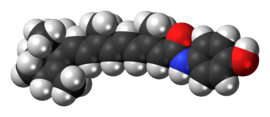Fenretinide
Fenretinide (4-hydroxy(phenyl)retinamide; 4-HPR) (INN) is a synthetic retinoid derivative. Retinoids are substances related to vitamin A. It has been investigated for potential use in the treatment of cancer, as well as in the treatment of cystic fibrosis,[1] rheumatoid arthritis, acne, psoriasis, and has been found to also slow the production and accumulation of a toxin that leads to vision loss in Stargardt's patients.[2]
 | |
 | |
| Names | |
|---|---|
| IUPAC name
15-[(4-hydroxyphenyl)amino]retinal | |
| Identifiers | |
CAS Number |
|
3D model (JSmol) |
|
| ChEMBL | |
| ChemSpider | |
| DrugBank | |
| ECHA InfoCard | 100.164.069 |
| KEGG | |
| MeSH | Fenretinide |
PubChem CID |
|
| UNII | |
CompTox Dashboard (EPA) |
|
InChI
| |
SMILES
| |
| Properties | |
Chemical formula |
C26H33NO2 |
| Molar mass | 391.546 g/mol |
Except where otherwise noted, data are given for materials in their standard state (at 25 °C [77 °F], 100 kPa). | |
| Infobox references | |
In cancer studies, Fenretinide treatment may cause ceramide (a wax-like substance) to build up in tumor cells and is associated with the accumulation of reactive oxygen species (ROS), resulting in cell death through apoptosis and/or necrosis.[3] Fenretinide accumulates preferentially in fatty tissue such as the breast, which may contribute to the effectiveness of fenretinide against breast cancer.[4][5] Phase III clinical trial data has suggested that fenretinide reduces breast cancer relapse in pre-menopausal women.[6] Common side effects associated with fenretinide treatment include skin dryness and night-blindness, which is reversible upon cessation of treatment. Specific types of cancer under investigation include or have included ovarian, prostate, cervical, lung, renal, bladder, breast, glioma, skin, head and neck carcinoma, non-Hodgkin's lymphoma, neuroblastoma, and Ewing's sarcoma.
References
- Guilbault C, De Sanctis JB, Wojewodka G, Saeed Z, Lachance C, Skinner TA, Vilela RM, Kubow S, Lands LC, Hajduch M, Matouk E, Radzioch D (January 2008). "Fenretinide corrects newly found ceramide deficiency in cystic fibrosis". American Journal of Respiratory Cell and Molecular Biology. 38 (1): 47–56. doi:10.1165/rcmb.2007-0036OC. PMID 17656682.
- Radu RA, Han Y, Bui TV, Nusinowitz S, Bok D, Lichter J, Widder K, Travis GH, Mata NL (December 2005). "Reductions in serum vitamin A arrest accumulation of toxic retinal fluorophores: a potential therapy for treatment of lipofuscin-based retinal diseases". Investigative Ophthalmology & Visual Science. 46 (12): 4393–401. doi:10.1167/iovs.05-0820. PMID 16303925.
- Wu JM, DiPietrantonio AM, Hsieh TC (October 2001). "Mechanism of fenretinide (4-HPR)-induced cell death". Apoptosis. 6 (5): 377–88. doi:10.1023/A:1011342220621. PMID 11483862.
- Formelli F, Clerici M, Campa T, Di Mauro MG, Magni A, Mascotti G, Moglia D, De Palo G, Costa A, Veronesi U (October 1993). "Five-year administration of fenretinide: pharmacokinetics and effects on plasma retinol concentrations". Journal of Clinical Oncology. 11 (10): 2036–42. doi:10.1200/jco.1993.11.10.2036. PMID 8410127.
- Sabichi AL, Modiano MR, Lee JJ, Peng YM, Xu MJ, Villar H, Dalton WS, Lippman SM (July 2003). "Breast tissue accumulation of retinamides in a randomized short-term study of fenretinide". Clinical Cancer Research. 9 (7): 2400–5. PMID 12855611.
- Veronesi U, Mariani L, Decensi A, Formelli F, Camerini T, Miceli R, Di Mauro MG, Costa A, Marubini E, Sporn MB, De Palo G (July 2006). "Fifteen-year results of a randomized phase III trial of fenretinide to prevent second breast cancer". Annals of Oncology. 17 (7): 1065–71. doi:10.1093/annonc/mdl047. PMID 16675486.
External links
- Numerous references and links to current and past clinical trials and studies of fenretinide can be found at the Journal of Clinical Oncology website